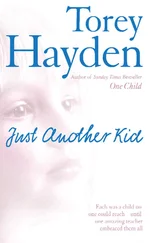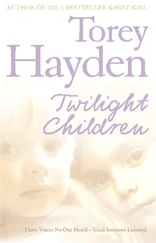He began talking while I was, but when I stopped, he stopped. He still stared above him, although there was no focus to the gaze.
“What did you say, Boo?”
No response.
“Did you want to talk about something?”
Still looking blankly into space. “The high today will be about 65, the low tonight in the middle forties. In the mountain valleys there is a chance of frost. The high at the airport yesterday was 56. In Falls City it was 61.”
“Boo? Boo?” I softly touched his face. Loose black curls flopped back onto the carpet where he lay. The picture-book beauty lay over his features like a separate entity. His fingers waggled against the rug. I was touching him, buttoning his shirt, moving slowly but certainly up his chest. I might as well have been dressing a doll. All the while he continued talking, parroting back the morning weather report exactly, word for word. Delayed echolalia, if one wanted the technical term for it. If that mattered.
“Chance of precipitation in the Greenwood area, 20 percent today, 10 percent tonight and then rising to 50 percent by morning. It looks like it is going to be a beautiful autumn day here in the Midland Empire. And now for Ron Neilsen with the sports. Stay tuned. Don’t go away.”
Don’t worry. I won’t.
We were piloting a reading series program in the primary grades that year. For me it was not a new program. The school I had previously taught in had also piloted the program. I got to live through the disaster twice.
The program itself was aesthetically outstanding. The publishers had obviously engaged true artistic talent to do the layouts and illustrations. Many of the stories were of literary quality. They were fun stories to read.
Unless, of course, you could not read.
It was a reading series designed for adults, for the adults who bought it, for the adults who had to read it, for the adults who had forgotten what it was like to be six and not know how to read. This series was a response to the community agitators who as forty-year-olds were not fascinated by the controlled vocabulary of a basal reader. They had demanded something more and now they had gotten it. As children’s books for adults, those in the series were peerless. In fact, the first time I had encountered the books, I had covertly dragged home every single reader at one time or another because I wanted to read them. Of course, I was twenty-six. We bought the books, the children did not, and in this case we bought the books for ourselves.
For the kids it was all a different matter. Or at least for my kids. I had always taught beginners or failures. For these two groups the reading program was an unmitigated disaster.
The major difficulty was that, in order to appeal to adults from the first pre-primer on, the series had dispensed with the usual small words, short sentences and controlled vocabulary. Even the pictures accompanying the text, though artistic, were rarely illustrative of the story at hand. The first sentence in the very first book intended for nonreading six-year-olds had eight words including one with three syllables. For some of the children this was all right. They managed the first sentence and all the others after it. For the majority of children, including mine, well … in the three years I had used the series, I had memorized the three pre-primers because never in all that time did any of my children advance to another book. Normally, the first three pre-primers were mastered in the first grade, before Christmas.
I was not the only person having problems. In the first year of piloting, word soon got around in the teachers’ lounge: None of the first- or second-grade teachers was having much success. Traditionally, publishers of reading series send a chart outlining the approximate place a teacher and her class should be at any given time in the term. We all gauged our reading programs around that chart so that we could have our children properly prepared for the next grade by the end of school. This publisher’s chart hung in the lounge that first year, and the five of us, two first-grade teachers, two second-grade teachers, and I with my primary special education class, would moan to see ourselves slip further and further behind where the publisher predicted we should be. No one was going to get through the program on time.
After a few months of struggling we became so incensed over this impossible series that we demanded some sort of explanation from the school district for this insanity. The outcome of the protest had been the arrival from the publishing company of a sales representative to answer our questions. When I brought up the fact that less than half of all the children in the program were functioning where the chart said they should be, I expected I had set myself up to be told my colleagues and I just were not good teachers. But no. The salesman was delighted. He smiled and reassured us that we were doing very well indeed. The truth was, he said, only 15 percent of all first graders were expected to complete the entire first-grade program during the first grade. The other 85 percent were not.
I was horrified beyond reply. We were using a program that by its very construction set children up to fail. All except the very brightest were destined to be “slow readers.” Many, many teachers not hearing this man’s words were going to assume that the chart was correct and put their children through an entire year’s program under the mistaken belief that all the first-grade material was meant to be done in the first grade, none in second. That was not too extravagant an assumption, in my opinion. Worst of all, however, was that as the years went on, perfectly ordinary children who were learning and developing at normal rates would fall further and further behind, so that by fifth or sixth grade they could conceivably be considered remedial readers because they were two or more books behind their grade placement, when in fact they were right where the publisher expected them to be. And of course nothing could ever be said to these children who were reading fourth-grade books in sixth that would convince them that they were anything other than stupid. It was nothing more than statistics to the publishing company. For the kids it was life. That was such a bitterly high price to pay for an aesthetically pleasing book.
Lori was one of the reading series’ unwilling victims. Already a handicapped student who undoubtedly would always have trouble with symbolic language, Lori was trapped with an impossible set of books and a teacher who despised both the books and special students.
Edna Thorsen, Lori’s teacher, was an older woman with many, many years of experience behind her. Due for retirement the next year, Edna had been in the field since before I was born. In many areas of teaching Edna was superb. Unfortunately, special children was not one of them. She firmly believed that no exceptional or handicapped child should be in a regular classroom, with perhaps the exception of the gifted, and even of that she was unsure. Not only did these children put an unfair burden on the teacher, she maintained, but they disallowed a good education for the rest of the class because of the teacher time they absorbed. Besides, Edna believed, six-year-olds were just too young to be exposed to the rawness of life that the exceptional children represented. There was plenty of time when they were older to learn about blindness and retardation and mental illness.
Edna kept to many of the more traditional methods of teaching. Her class sat in rows, always stood when addressing her, moved in lines and did not speak until spoken to. They also progressed through the reading program exactly according to the chart sent out by the publishing company. If in the second week of November the children were to be, according to the charts, up to Book #2, page 14, all three of Edna’s little reading groups were within a few pages one way or the other of Book #2, page 14, the second week in November. She had no concept of the notion that only 15 percent of the children were actually expected to be there and all the rest behind. Her sole responsibility, she said, was to see that all twenty-seven children in her room had gone through the three pre-primers, the primer and the first-grade reader by that last day of school in June and were ready for second grade. That all her children could not read those books had no bearing in Edna’s mind on anything. Her job was to present the material and she did. It was theirs to learn it. That some did not was their fault, not hers.
Читать дальше












